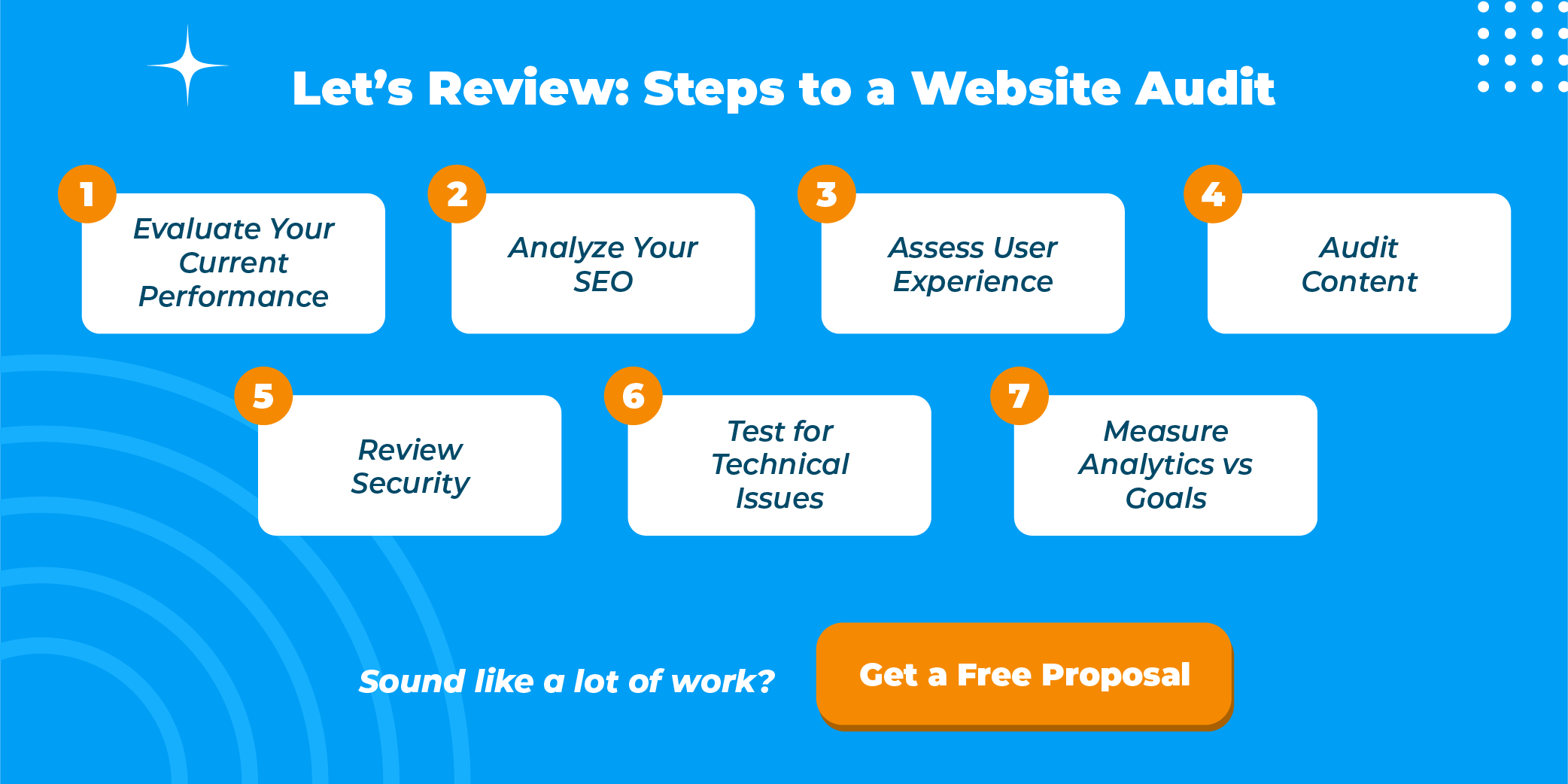In the digital era, your website is often the first point of contact between your business and potential customers. A well-functioning, optimized website is essential for improving visibility, user experience, and conversions. To ensure your site performs at its best, conducting a comprehensive website audit is key.
Table of Contents
- What is a Website Audit?
- Why Audit a Website?
- Tools You Need to Audit a Website
- 1: Evaluate Website Performance
- 2: Analyze SEO
- 3: Assess User Experience
- 4: Audit Content
- 5: Review Security
- 6: Test for Technical Issues
- 7: Measure Analytics and Goals
- Creating an Actionable Website Audit Report
- Partner with BizIQ for Website Success
What Is a Website Audit?
A website audit is a thorough analysis of your website’s performance, usability, search engine optimization (SEO), and technical health. It evaluates how well your site serves its intended purpose, whether that’s generating leads, driving sales, or sharing information. By uncovering critical issues and potential enhancements, a website audit provides actionable insights to improve your online presence.
Why Audit a Website?
Regular website audits are crucial for maintaining a competitive edge. Here’s why:
- Boost SEO: Identify and fix SEO issues that prevent your site from ranking high on search engine results pages (SERPs).
- Enhance User Experience (UX): Ensure visitors can navigate your site easily, improving engagement and reducing bounce rates.
- Optimize Performance: Address slow loading times, broken links, or other issues that hinder functionality.
- Adapt to Trends: Keep your site updated with the latest digital marketing and design trends.
Tools You Need to Audit a Website
Before you begin, equip yourself with the right tools to make your audit efficient and effective:
- SEO Tools: Google Analytics, Google Search Console, SEMrush, Ahrefs, and Screaming Frog.
- Speed Testing Tools: Google PageSpeed Insights, GTmetrix, and Pingdom.
- UX Analysis Tools: Hotjar, Crazy Egg, or FullStory.
- Technical Tools: W3C Validator, SSL Checker, and browser developer tools.
Get a Free Marketing Analysis! →
Step 1: Evaluate Website Performance
The first step in auditing a website is to assess its performance. A slow-loading website can frustrate users and harm your search rankings. Use tools like Google PageSpeed Insights or GTmetrix to evaluate:
- Page Load Times: Aim for under three seconds.
- Mobile Responsiveness: Ensure the site adapts seamlessly to different screen sizes.
- Core Web Vitals: Measure metrics like Largest Contentful Paint (LCP), First Input Delay (FID), and Cumulative Layout Shift (CLS).
Step 2: Analyze SEO
- SEO is critical for driving organic traffic. Break your SEO audit into these key areas:
Keyword Research
- Check if your website targets the right keywords. Use tools like Ahrefs or SEMrush to identify keywords with high search volume and relevance to your business.
On-Page SEO
- Optimize titles, meta descriptions, headers, and image alt text with relevant keywords.
- Ensure content is high-quality, unique, and engaging.
Technical SEO
- Verify that your sitemap.xml and robots.txt files are properly configured.
- Check for crawl errors and indexing issues in Google Search Console.
- Ensure URLs are clean and descriptive.
Backlink Profile
- Analyze your backlinks using tools like Ahrefs to ensure you have high-quality, authoritative links.
- Disavow spammy or harmful backlinks.
Step 3: Assess User Experience (UX)
User experience directly impacts engagement and conversions. Evaluate the following aspects:
Navigation
- Is the website easy to navigate with a clear menu structure?
- Are important pages accessible within 3-4 clicks?
Design
- Check for consistent branding, a visually appealing layout, and proper use of whitespace.
- Ensure buttons, links, and forms are easy to locate and use.
Mobile-Friendliness
- Use Google’s Mobile-Friendly Test to ensure your site performs well on smartphones and tablets.
Accessibility
- Confirm that your website meets accessibility standards like WCAG, ensuring it is usable by people with disabilities.
Step 4: Audit Content
Content is the backbone of your website. Assess it for quality, relevance, and engagement:
Content Quality
- Review all pages to ensure content is accurate, compelling, and free of grammatical errors.
- Identify outdated content and update it with fresh information.
Blog and Resource Pages
- Are blog posts optimized for SEO with targeted keywords and engaging titles?
- Is there a consistent posting schedule to keep your audience engaged?
Calls to Action (CTAs)
- Ensure CTAs are clear, visible, and aligned with your goals (e.g., “Contact Us,” “Buy Now”).
Step 5: Review Security
Security is a non-negotiable aspect of your website. A secure site builds trust and protects your data:
- SSL Certificate: Ensure your site uses HTTPS, indicating it is secure.
- Data Protection: Verify that sensitive information (e.g., payment details) is encrypted.
- Regular Updates: Check if your CMS, plugins, and themes are updated to the latest versions.
Step 6: Test for Technical Issues
A technically sound website ensures smooth operations. Test for:
- Broken Links: Use tools like Broken Link Checker to find and fix non-working links.
- Error Pages: Ensure custom 404 pages guide users back to your site.
- Duplicate Content: Use Copyscape or Siteliner to identify duplicate content that could harm SEO.
- Structured Data: Validate your schema markup to enhance search engine understanding.
Step 7: Measure Analytics and Goals
Finally, dive into your analytics to assess how your website is performing against your objectives:
- Traffic Sources: Determine where visitors are coming from (organic, direct, referral, or paid).
- User Behavior: Analyze metrics like bounce rate, time on page, and pages per session.
- Conversion Rates: Are users completing desired actions, like filling out forms or making purchases?
Creating an Actionable Website Audit Report
Once you’ve completed your audit, compile your findings into a clear, actionable report. Highlight:
- Strengths: What’s working well on your site.
- Weaknesses: Issues that need to be addressed.
- Opportunities: Areas for improvement or growth.
- Action Plan: A prioritized list of tasks, timelines, and goals.
Partner with BizIQ for Website Success
Auditing a website is a comprehensive process, but the results are well worth the effort. By following this guide, you can optimize your site for better SEO, user experience, and performance. However, executing these tasks effectively requires expertise and time.
That’s where BizIQ comes in. Whether you need help with local or organic SEO, PPC campaigns, social media management, website design, or development, we’re here to help. Our team of digital marketing authorities is committed to helping your company grow and succeed online.
Contact BizIQ today for a professional website analysis and quote. Let us show you how our tailored strategies can elevate your digital presence and drive results.



